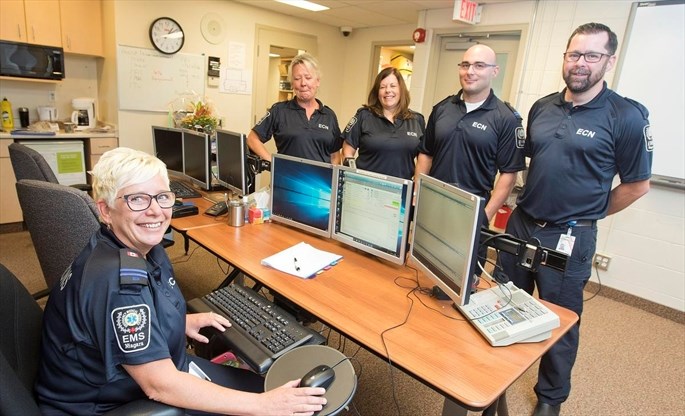An initiative that added the expertise of nurses to handle non-critical 911 calls in Niagara Region is lowering the number of ambulances having to rush to scenes.

Niagara EMS says adding an emergency communications nurse (ECN) to its system five years ago has been an important piece that’s contributed to a 20 per cent shrinkage of paramedics calls since 2019.
The effort seeks to eliminate unneeded ambulance calls and offer an effective alternative care method, avoiding a visit to a crowded emergency room.
The commander of Niagara’s Mobile Integrated Health Care unit says the program recently surpassed its 16,000th “low acuity” call triaged to an ECN, easing pressure on a network that handles some 70,000 911 calls a year.
Niagara EMS’s Marty Mako says about 20 per cent of the screenings through an ECN lead to a deferral which stops an EMS resource from having to be deployed.
Lower back pain, a nosebleed or a child with a fever are some examples of lower-priority occurrences the framework could pivot to another agency.
“So that means we’ve been able to find people that care they need in the community without sending an ambulance and two paramedics, when they really weren’t needed,” Mako said.
“And we do that 24-hour call back to make sure that people were satisfied.”

The program came after a study between 2011 and 2016 exploring the efficacy of implementing ECNs to conduct secondary-level responses to “non-emergent” 911 calls.
It followed another analysis that revealed Niagara had the largest growth in EMS calls across Ontario, some 55 per cent, which was almost double the average provincial growth of 30 per cent between 2007 and 2016.
At the time, 44 per cent of Niagara 911 calls required an ambulance to rush out with lights and sirens.
The initial proposal called for a concept that would use algorithms to identify callers whose health needs could be redirected to a walk-in clinic, urgent care centre or even pharmacist for a medication-related issue.
Mako says “evidence-based” software, called “LowCode,” performs a secondary triage on some calls and uses “signs and symptoms” to determine a patient’s health need.
“That way, using signs and symptoms from the patient, they can ask a series of questions over about an extra 10 or 15 minutes on the phone to come up with … a recommended care level,” Mako explained.
Niagara’s ECN blueprint was the first in Canada but not the only one, with Nova Scotia and Quebec having similar schemes that added nurses to emergency calls.
Nova Scotia’s Emergency Health Services (EHS) Medical Communications Centre launched a version in November of 2022, taking it a step further by adding not only a nurse, but also a physician and clinical support paramedic.
The EHS said its call centre received close to 185,000 calls in 2021, with about a third not needing patient transport.
Within the first six months of the launch, EHS reported that nurses fielded about 500 calls for issues that weren’t life-threatening.
“The adage was you call, we haul. We’re trying to move away from that and have a clinical understanding of providing the right resource to the right patient,” said Ahmed Jamshidi, the manager of patient flow and performance for the EHS.
“Even if we get five per cent or 10 per cent to not go to the hospital it takes that load off the emergency departments and the overall system as well.”
Meanwhile, Quebec launched its one-year pilot in 2018 for Montreal and Laval, which saw some 23,000 non-urgent calls transferred to the 811 Info-Santé health advice service.
In almost 20 per cent of calls during the pilot, a nurse determined there was no need for an ambulance.
Mako says recent inquiries from across Canada about Niagara’s program suggest the idea may expand even further.
But he says it’s not for every community since it not only requires accreditation through the International Academy of Emergency Dispatch and other agencies, but software has to be linked with a fairly modern paramedic dispatch system.
“It’s important to understand there could be other EMS services out there that would like to model after us, but structurally they cannot because they don’t have the same systems as a precursor,” said Mako.




Comments